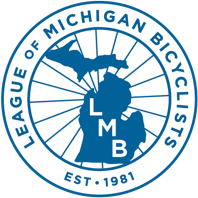LMB offered the following public comment in advance of the March 19, 2024 meeting of the Governor’s Traffic Safety Advisory Commission:
March 14, 2024
Dear members of the Governors Traffic Safety Advisory Commission:
In my capacity as the Communications and Advocacy Director of the League of Michigan Bicyclists, I have closely followed our state’s efforts to improve the safety of roadways for people who bike and walk, and advocated for legislative changes including the hands-free distracted driving law and a speed limit bill (HB 4012) currently awaiting Senate action.
In 2024, let’s continue our progress. LMB would like to suggest a potential approach for one of the strategies in the recent MDOT VRU Safety Assessment (note 1), dated Nov. 8, 2023, and offer our support and assistance to carry it out.
First, some background. The following statutory requirements apply to the assessment, according to FHWA guidance (note 2, p. 7):
As part of the Vulnerable Road User Safety Assessment, the State shall use a data-driven process to identify areas of high-risk for vulnerable road users. (23 U.S.C. 148(l)(2)(A)). The State must … develop a program of projects or strategies to reduce safety risks to vulnerable road users in areas identified as high-risk(23 U.S.C. 148(l)(2)(B)). (emphasis added)
The assessment describes the high-risk network on p. 39 (see attached excerpt) as follows:
About 14 percent of this network is in rural areas while 86 percent is in urban areas. By classification, this research independently identified a significant length of arterial roadways – 96 percent of the identified high-risk network. When focusing on fatal and serious injury pedestrian and bicycle crashes, the numbers are clear: focusing our attention on arterial roadways offers the greatest potential for decisively reducing the number of fatal and serious injury pedestrian crashes on Michigan’s roadways. (emphasis in original)
The actual road segments making up the high-risk network are found in an appendix to MDOT research report SPR-1734, “Effective Pedestrian/Non-Motorized Crossing Enhancements along Higher Speed Corridors.” (note 3) For ease of reference, we created a Google map compiling them at https://LMB.org/highrisk – with thanks to Dr. Jun Oh and his team for providing the data.
The FHWA guidance provides the following commentary on preferred strategies (p. 12):
FHWA encourages States to prioritize countermeasures and strategies as follows to align with the Safe System Approach:
-
-
- Separate users in space (e.g., separated bike lanes, walkways, pedestrian refuge islands)
- Implement physical features to slow traffic (e.g., self-enforcing roads, road diets)
- Separate users in time (e.g., leading pedestrian interval)
- Increase attentiveness and awareness (e.g., crosswalk visibility enhancements, pedestrian hybrid beacons, lighting)
- Implement speed enforcing strategies (e.g., speed safety cameras)
-
It is also important to note that issues may vary by area type (e.g., there may be different issues for rural, urban, or suburban areas). States should also consider these potential differences and apply appropriate strategies based on context.
Returning to the VRU Safety Assessment, the “Strategies and Countermeasures” section starts on p. 70. One of the listed strategies reads as follows:
Multidisciplinary Involvement
-
- Work with the Governor’s Traffic Safety Advisory Commission’s Communications Committee to identify a strategy for promoting pedestrian and bicyclist safety statewide.
- Work with the Governor’s Traffic Safety Advisory Commission’s Communications Committee to identify a strategy for promoting pedestrian and bicyclist safety statewide.
In order to align the GTSAC’s Communications Committee strategy with the FHWA’s priorities for a Safe System Approach, we wish to draw your attention to a recent technical report from the AAA Foundation for Traffic Safety, “A Safe System Guide for Transportation: Sharing this Approach to Lead Your Community to Action” (note 4).
LMB would like to offer our support to GTSAC in developing a communications strategy for promoting pedestrian and bicyclist safety and the Safe System Approach using the Values-Solutions-Action Framework created by the AAA Foundation.
Several of the remaining strategies in the VRU Safety Assessment do not align with the Safe System Approach and are carried over verbatim from a 2018 assessment (note 5, p. 8-9). Setting those aside, we appreciate the assessment’s identification of high-risk areas for vulnerable roadway users and its focus on urban arterials. We believe that a concerted effort to apply the findings of SPR-1734 and shift from a traditional mindset to a Safe System Approach can bear significant fruit in the effort to eliminate traffic deaths in Michigan.
Sincerely,
Matt Penniman
Communications and Advocacy Director
League of Michigan Bicyclists
Categorised in: Uncategorized
